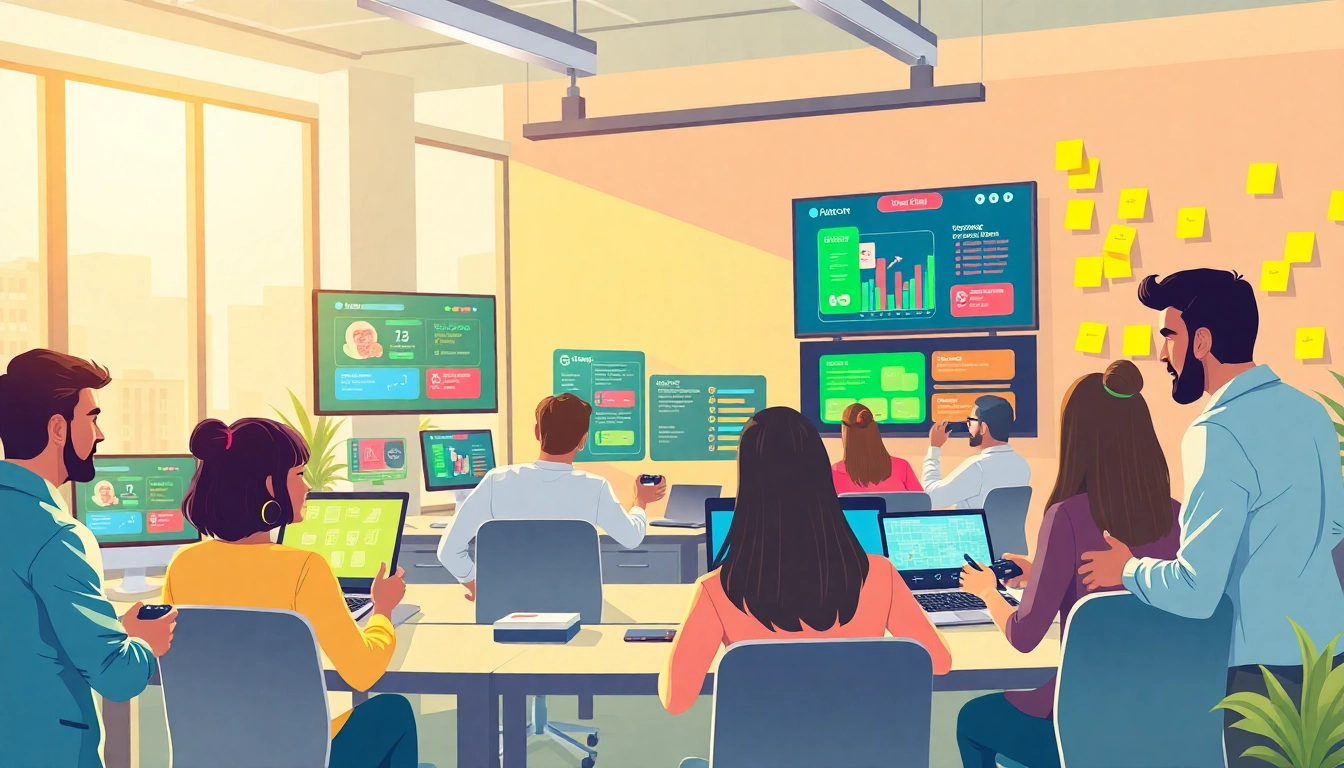Understanding Gamification: The Future of Engagement
What is Gamification and Its Importance?
Gamification, derived from the word “game,” refers to the use of game design elements in non-game contexts to enhance user engagement, motivation, and behavioral change. In recent years, businesses across diverse sectors have recognized the power of gamification as a vital tool for improving employee engagement, customer loyalty, and learning outcomes. Companies are increasingly turning to a gamification company to leverage game-like mechanics to captivate their audience and drive results.
At its core, gamification taps into intrinsic motivators such as competition, achievement, and social interaction. By incorporating elements like points, badges, leaderboards, and challenges, gamification transforms mundane tasks into interactive experiences, making engagement and learning enjoyable. This revolutionary approach not only fosters better participation but also encourages users to learn new skills or behaviors more effectively.
How a Gamification Company Transforms Businesses
A specialized gamification company offers a wealth of resources and expertise to organizations seeking to integrate game mechanics into their operations. By collaborating with a gamification partner, businesses can develop customized solutions that align with their specific goals, whether that’s enhancing employee performance or boosting customer retention. The transformation process involves analyzing an organization’s needs, identifying goals, and designing experiences that promote user involvement and learning.
One fundamental way such companies facilitate transformation is through behavioral design. This approach utilizes insights from psychology and behavioral economics to craft experiences that influence user outcomes. The result is a finely-tuned gamified system that not only engages users but also drives them towards desired behaviors.
Key Benefits of Gamification for Employee Engagement
The adoption of gamification strategies can yield remarkable benefits for employee engagement, including:
- Increased Motivation: Gamification turns goal-setting and progress tracking into a playful experience that motivates employees to excel.
- Enhanced Collaboration: Features like leaderboards and team challenges promote collaboration and foster a competitive spirit among teams.
- Improved Learning and Skills Development: Gamified training programs make learning interactive and efficient, yielding better retention of knowledge.
- Real-Time Feedback: Continuous feedback mechanisms incorporated in gamified solutions allow employees to monitor their performance and understand areas for improvement instantly.
Types of Gamification Strategies for Businesses
Point Systems and Rewards: Fundamental Approaches
Point systems and rewards are at the heart of many gamification strategies. These mechanisms incentivize users to engage with products, services, or learning content. By awarding points for completing tasks, attending training, or achieving specific goals, businesses can create a measurable framework for user achievement. Over time, these points can translate into tangible rewards such as discounts, recognition, or even career advancements, fostering ongoing engagement.
To implement a successful point system, companies must clearly define desired behaviors and establish a transparent way of tracking and rewarding user performance. Consistent communication around how users can earn points and what rewards are available is crucial to maintaining motivation.
Leaderboard Mechanics: Driving Healthy Competition
Leaderboards introduce an element of transparency and competition by displaying user rankings based on point accumulation or other performance metrics. This public accountability can motivate users to strive for better performance and to see how their efforts compare to their peers. Leaderboards can be designed for individual performance, team performance, or both.
Effective leaderboard strategies not only foster competition but also encourage collaboration, as users often work together to achieve higher group rankings. However, businesses should be cautious of creating overly competitive environments, which can lead to stress or diminished morale. It’s essential to balance competitive spirit with supportive community-building elements.
Challenges and Quests: Enhancing Experience
Challenges and quests are gamified components that further enrich the user experience by setting clear tasks and goals for users to accomplish. These could range from completing specific online training modules to participating in team-based activities that enhance skills or social interactions.
By integrating challenges and quests, businesses can create story-driven experiences that immerse participants in a narrative, making the learning or engagement process more enjoyable. These narratives can be tailored to resonate with the audience, allowing participants to connect with the content on a deeper level. To be effective, quests should be appropriately scaled and vary in difficulty to cater to diverse skill levels and interests.
Implementing Gamification: Steps to Success
Assessing Your Business Needs for Gamification
Before implementing gamification strategies, businesses must conduct a thorough assessment of their needs and goals. Understanding the specific challenges and objectives within an organization is critical in designing effective gamified solutions. This may involve gathering insights from employees or clients about their experiences and motivations, as well as identifying any existing engagement issues.
Consider questions such as: What specific behaviors do we want to encourage? Are there particular training gaps that need to be addressed? By obtaining clarity around these questions, businesses can effectively tailor gamification strategies towards achieving desired outcomes.
Choosing the Right Gamification Tools and Platforms
The next step is selecting suitable gamification tools and platforms. The market offers a wide array of software solutions equipped with various game mechanics, analytics capabilities, and customization options. Factors to consider when choosing a platform include:
- User Interface: The platform should be intuitive and user-friendly to ensure quick adoption by participants.
- Customization Capabilities: The ability to tailor experiences to align with organizational branding and user preferences is vital.
- Analytics and Reporting: Effective gamification should include robust tracking capabilities to measure engagement and success metrics.
- Integration: Consider how well the gamification tool integrates with other systems and platforms already in use within the organization.
Tailoring Content to Fit Your Audience’s Preferences
The success of gamification heavily depends on how well the content resonates with the target audience. Tailoring gamified elements to fit user preferences enhances engagement and satisfaction. Utilize feedback mechanisms to capture user sentiment and adapt content accordingly.
Additionally, creating personas that represent different user groups can help in designing experiences that appeal to varied demographics. By tailoring challenges, rewards, and narratives to suit different user profiles, companies can improve user retention and motivation rates significantly.
Measuring the Impact of Gamification
Performance Metrics: Analyzing Engagement and Retention
Once gamification strategies are implemented, measuring their effectiveness is crucial for ongoing improvement. Performance metrics such as user engagement rates, task completion rates, and overall satisfaction should be monitored regularly to assess the impact of gamification on business objectives.
Key performance indicators (KPIs) can vary based on organizational goals, but should always aim to measure the core aspects of the gamified solution, including engagement depth, the frequency of user interactions, and retention rates. Gathering and analyzing this data enables businesses to gauge whether their gamification efforts yield results and how they can refine their strategies.
Feedback Loops: Collecting User Insights
Establishing feedback loops is fundamental to understanding user experiences and optimizing gamification strategies. These loops can include surveys, reflection sessions, and informal discussions following engagement activities. Gathering user insights allows organizations to identify gaps, recognize successful elements, and refine less effective aspects of the gamified experience.
Additionally, implementing ongoing improvements based on user feedback strengthens trust and communication between users and the organization, fostering a more passionate community around the gamified initiatives.
Case Studies: Successful Examples from Gamification Companies
Examining case studies from successful gamification implementations can provide valuable lessons and inspiration for organizations looking to pursue similar paths. For instance, companies in the education sector, such as Duolingo, have utilized gamification to increase language acquisition by incorporating elements like points, levels, and achievements into their programs, cultivating a fun and effective learning atmosphere.
Similarly, enterprises like SAP have effectively integrated gamification within their organizational training programs. They reported substantial increases in knowledge retention and employee motivation by incorporating game-like aspects into training modules, illustrating that with the right approach, gamification can yield significant business outcomes.
Future Trends in Gamification
Emerging Technologies Shaping Gamification
As technology continues to evolve, it brings forth new opportunities for enhancing gamification experiences. Innovations such as augmented reality (AR) and virtual reality (VR) are reshaping the landscape by creating immersive experiences for users. Organizations are leveraging AR and VR to develop gamified training solutions that simulate real-world environments and behaviors, leading to more engaged and effective learning processes.
Artificial intelligence (AI) is also anticipated to play a pivotal role in personalizing gamification experiences by tailoring content and challenges to individual user profiles, thereby enhancing relevance and engagement.
How Gamification Will Evolve in Various Industries
Different industries will likely witness unique adaptations of gamification strategies to meet their distinct needs. In healthcare, for example, gamification can encourage patients to adhere to treatment plans through engaging reminders and rewards, thus promoting better health outcomes.
In the corporate world, training and onboarding processes are also set to be transformed as companies utilize gamification tactics to reduce time and expenses related to employee development while maximizing engagement and retention through enjoyable experiences.
The Role of Artificial Intelligence in Gamification
Artificial Intelligence is poised to significantly influence the future of gamification. Its ability to analyze massive datasets and discern behavior patterns empowers organizations to create optimized, personalized gamified experiences. For instance, AI can tailor challenges in real-time based on user interactions, ensuring that content is always relevant and motivational for different user segments.
Moreover, AI-driven analytics allow companies to collect and interpret vast amounts of engagement data, facilitating continuous improvement of gamified solutions. As organizations harness AI’s potential, the evolutionary journey of gamification will undoubtedly lead to even more engaging, effective, and personalized experiences for users.



